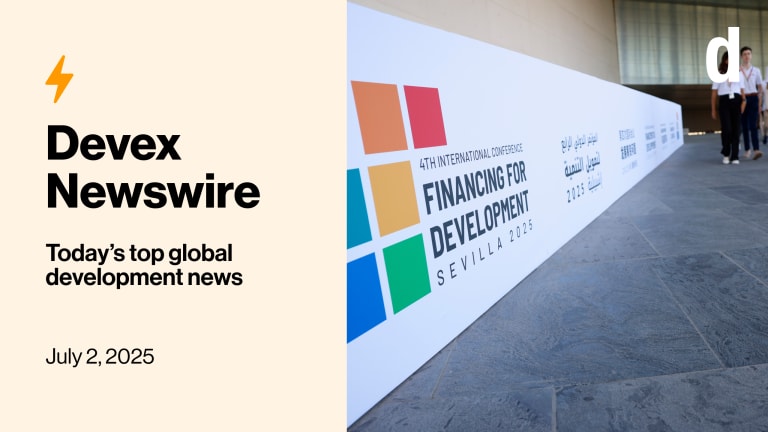The case for catalytic equity in climate and development finance
As the Ff4D summit in Sevilla nears, a Devex briefing explores why catalytic equity — early, risk-bearing capital — is critical to scaling climate finance in the global south.
With the Fourth International Conference on Financing for Development in Sevilla just around the corner, a familiar question is back on the agenda: Where will the money come from — and how do we make it flow where it’s needed most? Nearly a decade after the “billions to trillions” pledge was made in Addis Ababa, the gap between available capital and real investment in the global south remains stark. With climate needs growing and traditional aid budgets under pressure, hopes are high that Sevilla will offer more than a new slogan — and point to real, workable solutions. That was the backdrop for a recent Devex conversation between Devex President and Editor-in-Chief Raj Kumar and Ahmed Saeed, CEO of Allied Climate Partners — a philanthropy-backed investor focused on accelerating climate finance in emerging markets. Here are the key takeaways from their discussion — and why they matter for the road ahead. Catalytic equity: The riskiest slice — and the one most needed ACP makes philanthropically backed equity investments to help climate-focused funds in low- and middle-income countries get off the ground. This kind of funding is typically the first to be committed to a project or fund — absorbing the highest risk in order to attract additional, more commercially minded investors. This early-stage, or catalytic, equity is the riskiest slice of capital, and is still in short supply. And without it, most climate projects struggle to attract follow-on investment. One example: a $15 million commitment that helped launch a $175 million infrastructure fund in Southeast Asia, targeted at early-stage climate projects. But while catalytic equity is necessary, it’s not enough by itself. That’s where DFIs and multilateral development banks can play a role — by investing once the early risk has been absorbed. DFIs and MDBs benefit from partners who take the first risk Saeed, a former vice president at the Asian Development Bank, doesn’t join the chorus calling for multilateral development banks to abandon their AAA ratings or radically overhaul their risk models. He argued that their ability to stay safe and reliable — especially in times of crisis, such as during COVID-19 — is one of their greatest strengths, and worth preserving. While MDBs and development finance institutions are often tasked with mobilizing private capital, their ability to take on early-stage or high-risk investments is limited — especially when maintaining strong credit ratings is central to their role. That’s where players such as ACP can complement their work, using philanthropic capital to take on initial risk and help shape new investment funds. According to Saeed, this approach has already led to collaboration agreements with institutions such as the International Finance Corporation, the Inter-American Development Bank, and bilateral DFIs such as PROPARCO, FMO, and British International Investment — partnerships that, he said, have taken shape more smoothly than expected. Still, unlocking private capital at scale requires more than institutional alignment — it demands structural changes to the global financial system. Why ‘billions to trillions’ stalled before it started The ambition of mobilizing trillions in private finance was never matched with a plan. That, according to Saeed, is why the Addis-era framework faltered. The biggest problem? The global financial system simply wasn’t set up to channel savings from developed markets into investable opportunities in emerging ones. Investors in wealthier countries face strict regulations on where they can invest, and often lack the tools to assess or manage risk in unfamiliar markets. Many investment funds are also structured to require faster returns than those most climate projects in low- and middle-income countries can deliver. Even well-intentioned private equity funds often fail when applying U.S. or European models to contexts that require longer time horizons and more hands-on support. Saeed described the problem as having water stored high on a mountain — but without the plumbing to get it to the people below. The capital exists, in other words, but it’s not flowing to where it’s needed most. Carbon markets could help — if they reach those doing the work Voluntary carbon markets are often seen as a potential tool to channel funding from the gobal north to the global south. But according to Saeed, they remain more aspirational than operational — without clear rules, transparency, and infrastructure that works for all sides, few are willing to commit serious capital.. If carbon markets are to succeed, Saeed emphasized, they must do more than move money from wealthy countries to low- and middle-income ones — they must also ensure that the benefits reach local communities and individuals, such as smallholder farmers, who are directly contributing to emission reductions but often excluded from current systems. Building the infrastructure for a more trusted and inclusive carbon market, he said, will be critical to realizing its full potential. The bottom line: Put catalytic equity at the center Asked what message he hoped would come out of Sevilla, Saeed pointed to one priority: equity capital that is willing to take risk — particularly catalytic equity that can de-risk other forms of investment. He argued that development finance has historically focused too heavily on debt, leaving equity underused despite its central role in enabling projects to move forward. Institutions such as the World Bank Group, he noted, dedicate only a small share of their commitments to equity each year. For Saeed, Sevilla is an opportunity to redirect attention — and resources — toward this often overlooked but essential part of the capital stack. Without it, he warned, many investments simply won’t happen.
With the Fourth International Conference on Financing for Development in Sevilla just around the corner, a familiar question is back on the agenda: Where will the money come from — and how do we make it flow where it’s needed most?
Nearly a decade after the “billions to trillions” pledge was made in Addis Ababa, the gap between available capital and real investment in the global south remains stark. With climate needs growing and traditional aid budgets under pressure, hopes are high that Sevilla will offer more than a new slogan — and point to real, workable solutions.
That was the backdrop for a recent Devex conversation between Devex President and Editor-in-Chief Raj Kumar and Ahmed Saeed, CEO of Allied Climate Partners — a philanthropy-backed investor focused on accelerating climate finance in emerging markets.
This story is forDevex Promembers
Unlock this story now with a 15-day free trial of Devex Pro.
With a Devex Pro subscription you'll get access to deeper analysis and exclusive insights from our reporters and analysts.
Start my free trialRequest a group subscription Printing articles to share with others is a breach of our terms and conditions and copyright policy. Please use the sharing options on the left side of the article. Devex Pro members may share up to 10 articles per month using the Pro share tool ( ).
Raquel Alcega leads the data research and analysis at Devex, providing advice to organizations on the latest funding and programmatic trends that shape the global development space. She also heads up the news business content strategy and designs internal knowledge management processes. Prior to joining Devex’s Barcelona office, she worked in business development in Washington, D.C., and as a researcher in Russia and Mexico.








